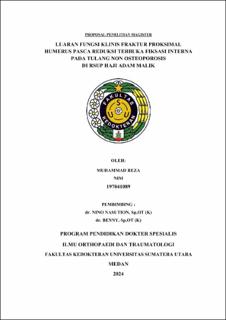| dc.description.abstract | Introduction
Proximal humeral fractures are complex injuries with significant morbidity. Treatment
protocols are determined by bone quality, fracture pattern, degree of comminution as well as
patient factors such as age and activity level and patient demand. Surgical options include
closed reduction and percutaneous Kirschner pinning, fixation with transosseous sutures, open
reduction and internal fixation with locking plates or conventional plates and hemiarthroplasty.
With the limited results of studies describing the clinical function outcomes of
proximal humeral fractures in open reduction with internal fixation using a proximal humerus
locking plate, this study aims to determine the DASH Score clinical function outcomes of open
reduction and internal fixation using the Proximal Humerus Locking plate in proximal humeral
fractures.
Methods
This study is a cross-sectional study that assesses the clinical outcome of proximal humeral
fracture treated with open reduction of internal fixation at Haji Adam Malik hospital from 2017
– 2023. Inclusion criteria were all patients diagnosed with proximal humerus fracture and
undergoing open reduction surgery internal fixation using Proximal Humerus Locking plate,
age 21-55 years, willing to become participants in the study after obtaining an explanation on
a voluntary basis and patients who have undergone ORIF using Proximal Humerus Locking
plate on the indication of proximal humerus fracture over 6 months when the DASH score
assessment. The exclusion criteria of the study were patients with a history of having
pathological fractures and running chemotherapy, patients suffering from post-operative
infections and patients with primary or secondary Osteoporosis.
Result
In this study, the largest gender is female, as many as 8 samples (72.7%). At the age of the
mean encountered in this study is 39.9 SD 16.38. Based on the fracture side found the most
fracture side is the right as many as 6 samples (54.5%). In Neer classification, the largest group
was Neer III, with 5 samples (45.4%). In the description of the average value of the DASH
score after ORIF on the proximal humerus fracture obtained the best value of the DASH Score
(Mean ± SD) obtained in the classification of Neer II is 14.15 ± 4.41. So it can be concluded
that the severity of the fracture also affects the outcome of functional outcomes assessed using
the DASH Score in patients with proximal humerus fractures performed ORIF action.
Discussion
In this study, it was found that the largest gender in this study was women, namely as many as
8 samples (72.7%). This is in accordance with the Iglesias-Rodríguez et al study in 2021 which
examined the epidemiology of proximal humeral fractures found a prevalence of 77.6% in
women with a ratio of 3.4:1 when compared to men. A statistically significant relationship was
found between the age and sex variables (p <0.001). In this study, based on the post-open
reduction DASH Score of internal fixation, the highest open reduction DASH score of internal
fixation is a very good score of 6 samples (54.5%). Based on Richard et al (2020) it was found
that the DASH score was the most widely used outcome measure at 31%. It takes into account
daily activities, symptoms, and social functions/roles over the past week. The DASH score has
been shown to have strong reliability and validity strong enough to assess patients with
proximal humeral fractures.
Conclusion
Based on the results obtained, it can be concluded that patients aged <50 years have a better
clinical function compared to patients aged >50 years, in the younger age group, men are more
likely to experience proximal humeral fractures. While in the older age group, women have
more proximal fractures of the humerus. A more numerous mechanism of injury in younger
age groups is traffic accidents. While in the older age group is a fall slip. | en_US |


